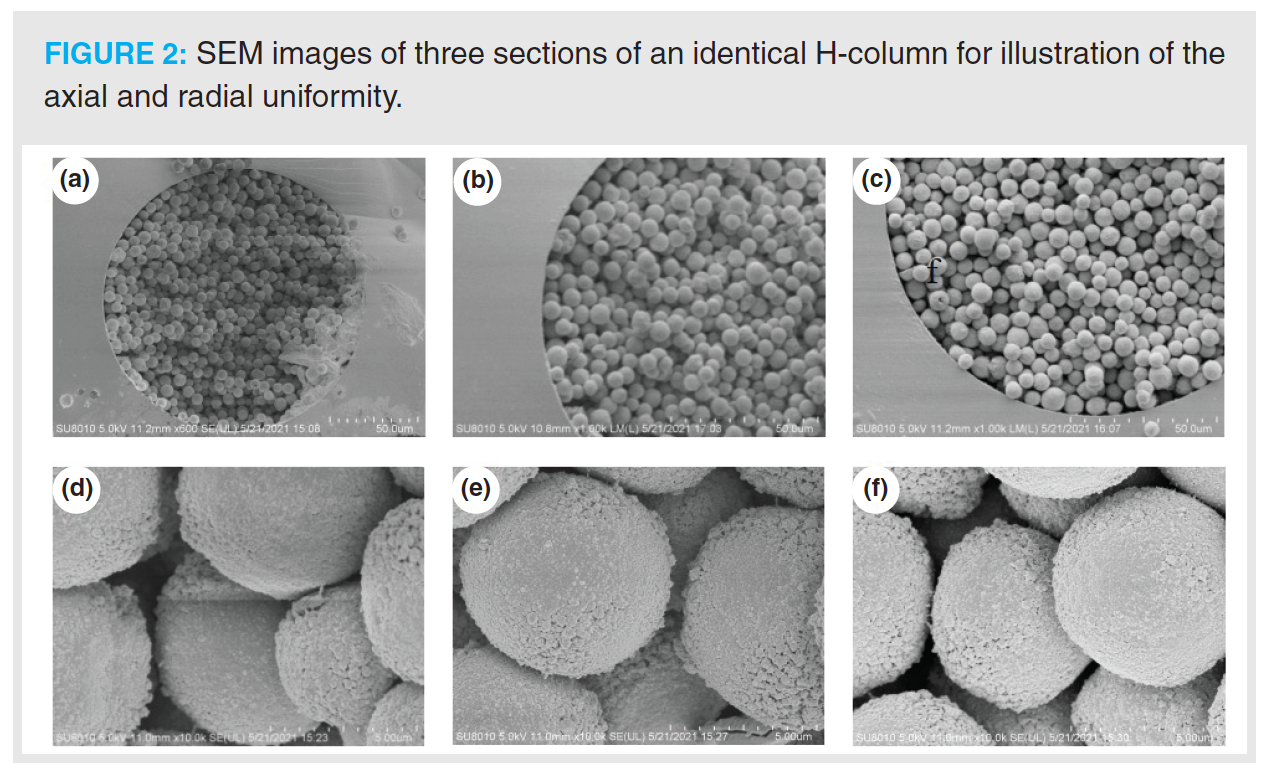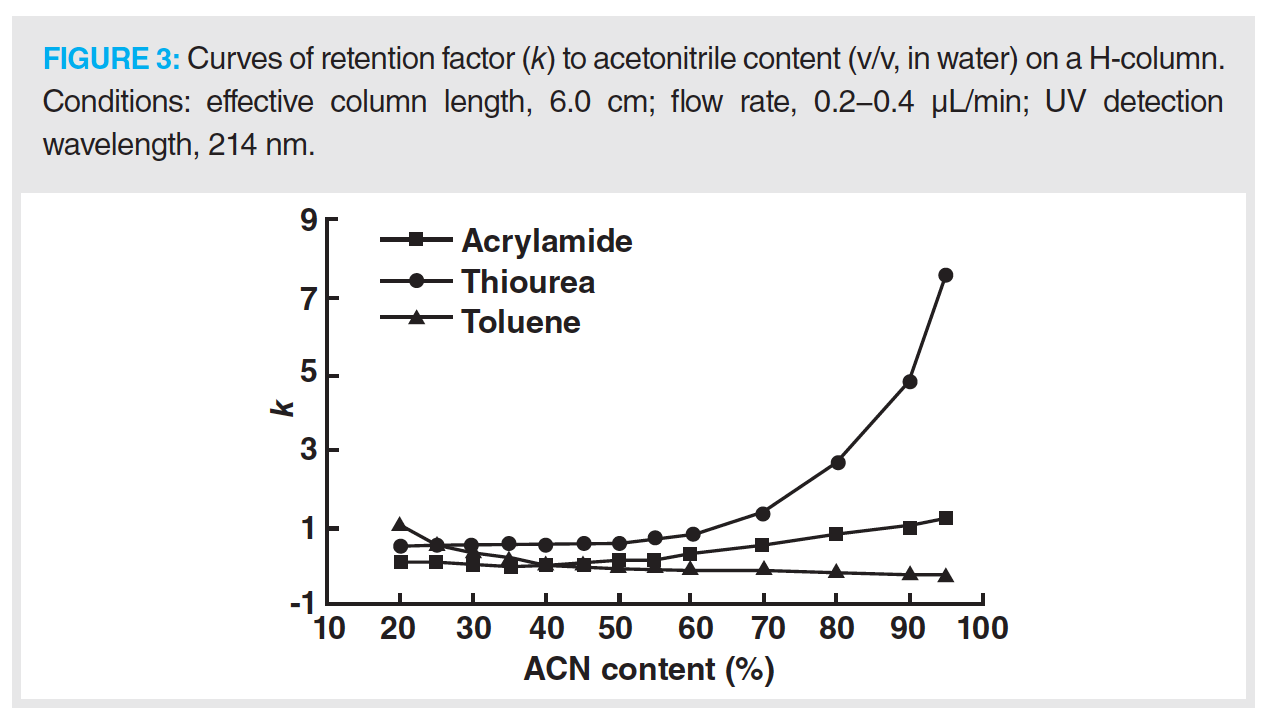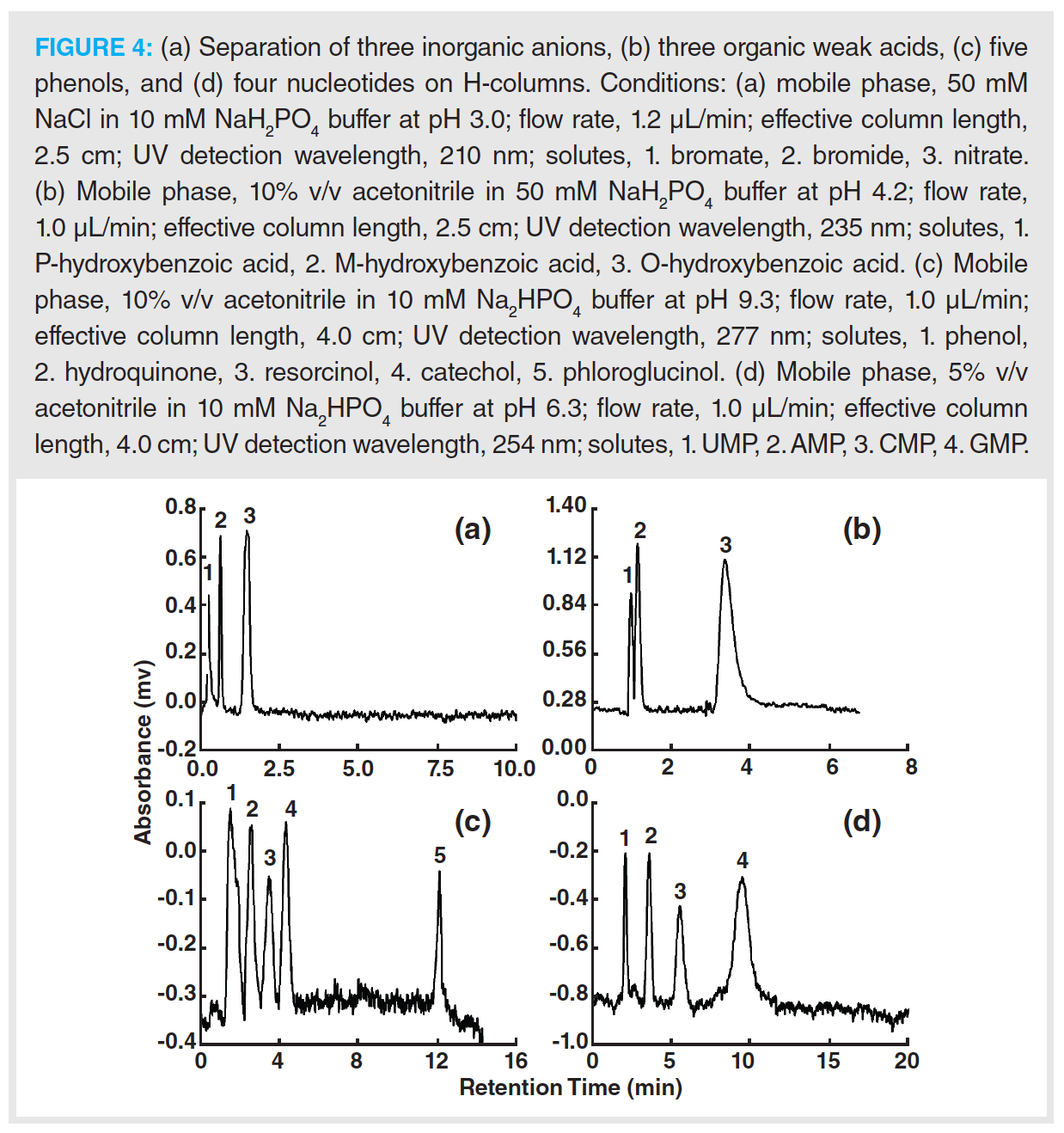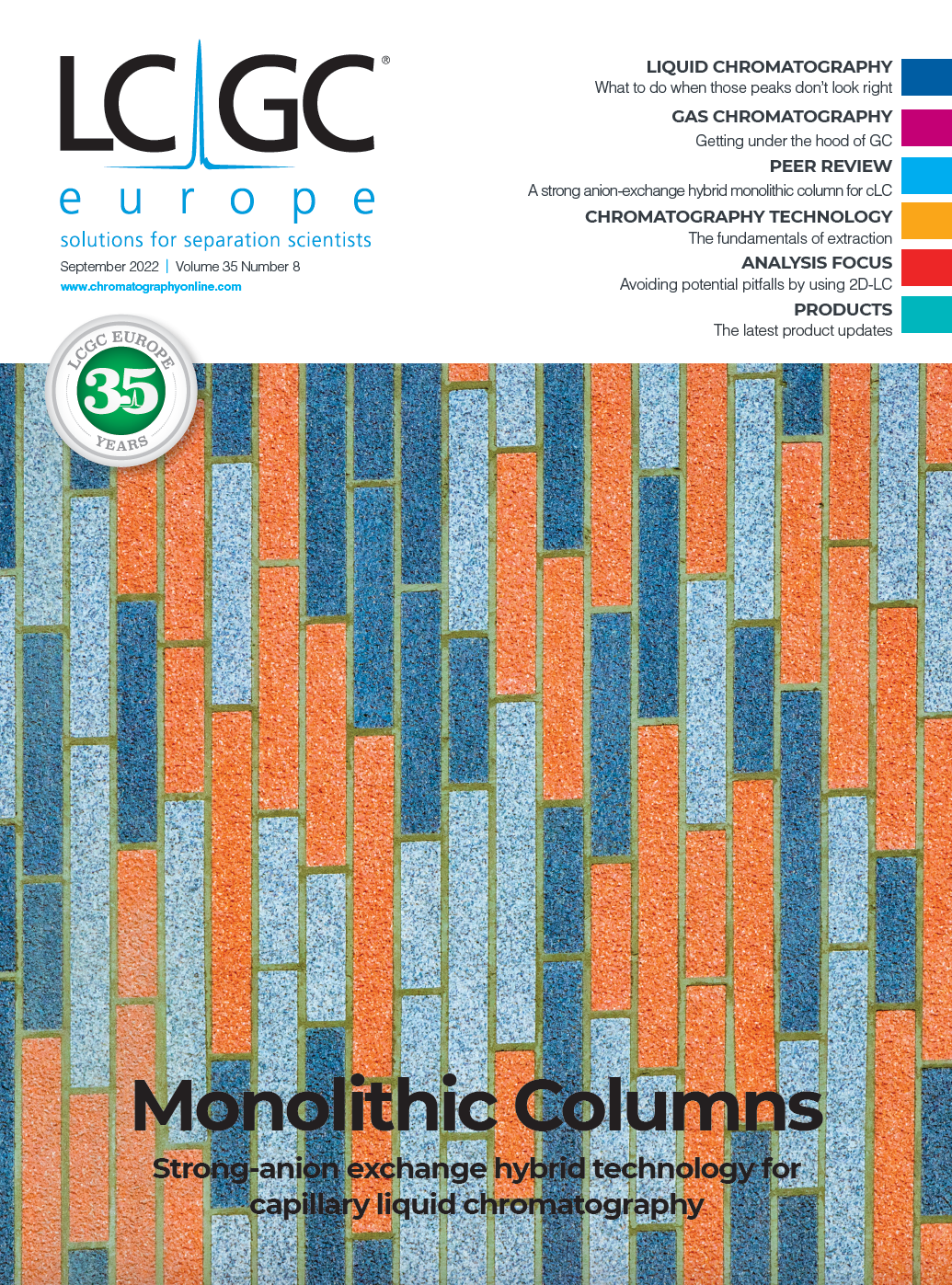A Hydrophilic Strong Anion-Exchange Hybrid Monolith for Capillary Liquid Chromatography
A hydrophilic strong anion-exchange monolithic hybrid column was prepared by in-capillary coating 5-µm bare silica particles with the copolymers of methacryloxyethyltrimethyl ammonium chloride and pentaerythritol triacrylate in the presence of a porogen consisting of water, methanol, and cyclohexanol. The composition of the porogen and the concentration of the monomers were investigated and selected. The resulting column was characterized. The column had an uniform pore structure and could withstand a back pressure up to 3500 psi. Its permeability was comparable to that of packed columns and the swelling-shrinking behaviour negligible. Its hydrophobicity could be suppressed at acetonitrile concentrations above 40% (v/v) and the minimum theoretical plate height was about 10 µm for BrÑ. The column-to-column relative standard deviations (RSDs) were 2.2% and 3.5% (n = 9) and the batch-to-batch RSDs were 2.4% and 5.5% (n = 3) for k and H values, respectively. The column exhibited a remarkable performanceforthe separation of inorganic anions, organic weak acids, phenols, and nucleotides.

Capillary liquid chromatography (cLC) offers high column efficiency, low consumption of sample and solvent, and good compatibility to mass spectrometry (MS) (1−4), which has led to widespread applications. Strong anion-exchange (SAX) columns are widely used to separate inorganic anions, organic weak acids, drugs, nucleotides, and proteins (5−9). For proteome analysis, SAX is often coupled with a reverse-phase column (5,10) and a two-dimensional separation system to substantially enlarge peak capacity. For the applications described previously, high hydrophilicity is desired. This allows a low content of organic modifier in the mobile phase to be used, and improves the orthogonality between SAX and reversed-phase mechanisms (5).
SAX columns can be prepared in the laboratory by packing capillaries with silica particles modified chemically with compounds containing quaternary ammonium groups (QAGs). QAGs are usually selected as the functional groups in SAX columns due to their ability to remain positive, even at high pH values, and their strong retention for anions. Packed columns possess good mechanical stability and almost no swelling-shrinking effects, but they do require retaining frits at both ends to trap the particles within the columns. The sintering process for the frits leads to band broadening, capillary fragility, chromatographic functionality degradation, and bubble formation in capillary electrochromatography (CEC) and cLC (4,11).
SAX columns can also be prepared by in-capillary synthesis of porous monoliths. Monolithic columns not only possess high permeability and column capacity but they also have none of the problems associated with the retaining frits. Depending on the matrix, reported monoliths are commonly classified into inorganically silica-based, organically polymer-based, or organically-inorganically hybrid monoliths (4). Jaafar et al. (12) have reported a silica-based SAX monolith. This column was prepared by chemically modifying a porous silica‑based monolithic matrix with a quaternary salt to introduce QAGs. Such silica-based monoliths have high permeability, little swelling-shrinking effect, and high mechanical stability, but they suffer from poor preparation reproducibility and tolerability to extreme pH. In addition, post‑modification is time-consuming (4,12,13). As a result, silica-based SAX monoliths have not been researched much. Several organic polymer-based SAX monoliths have been prepared through in‑capillary copolymerizing QAGs‑containing monomers and cross‑linkers in the presence of proper porogens (14−18). Such monoliths possess the merits of easy preparation, good tolerability to extreme pH, high permeability, and wide commercial availability of functional monomers (4,19), but they suffer from the swelling-shrinking effect (14,15). The swelling-shrinking effect is serious, particularly for organic polymer‑based strong ion-exchange monoliths, and is very harmful to mechanical stability, permeability, analytical performance, and lifetime. In addition, hydrocarbon moieties of the monomers and the C–C backbone of the monoliths contribute to undesired hydrophobicity (20). Such hydrophobicity can be lowered by using polar cross‑linkers, such as pentaerythritol triacrylate (PETA) (16) or poly (ethylene glycol) diacrylate (21). Organically‑inorganically hybrid monoliths combine the merits of organic polymer-based monoliths with inorganic silica-based monoliths, such as good mechanical stability, good tolerability to extreme pH, and high permeability. Several approaches have been reported for the preparation of hybrid monoliths (4,20,22−24). Among them, the most widely used is the “one-pot” method. Wang et al. (22) reported a hybrid monolith with mixed-mode of hydrophilic interaction and SAX using the “one-pot” method. This column was prepared through polycondensation of pre-hydrolyzed precursors of tetramethoxysilane and vinyltrimethoxysilane and then copolymerization of precondensed vinyltrimethoxysilane and 2-(acryloyloxy)ethyltrimethyl ammonium methyl sulfate, and was used in CEC.
Our team reported a zwitterionic monolith (25) and a hydrophilic strong cation-exchange monolith (26). They were prepared by in-capillary coating 5-µm bare silica particles with functional organic polymers. By adjusting the polarity of porogen and the total concentration of monomers, a thin layer of the polymers was formed only on the particle surface, leaving the interstitial space around the particles free for eluent flow. Such columns can be considered to be a hybrid of silica particles-packed and organic polymer‑based monolithic columns, and thus combine the merits of both of them. This article presents a new hydrophilic SAX hybrid monolithic column (shortened to H-column below), prepared in a similar way. After preparation conditions were investigated and selected, the resulting H-column was characterized in detail.
Experimental
Chemicals and Materials: Methacryloxyethyltrimethyl ammonium chloride (MATE) was produced by ACRŌS. Other chemicals and materials are described elsewhere (26).
Instruments: Chromatographic separations were conducted on a setup composed of a Model 500 liquid delivery pump from Lab Alliance, an in-house made T-splitter, and a Micro 21 UV-01 detector from Jasco (Japan). Morphology of monoliths was observed using a SU-8010 scanning electron microscope (SEM) from Hitachi. Data acquisition was implemented using a Lenovo computer equipped with a 24 bit analog-to-digital convertor and a N3000 software package from Zhejiang University. Chromatograms were reproduced using Origin software (OriginLab) based on the original data.
Preparation of the H-Column: The capillary was pretreated and pre-vinylized as described elsewhere (25). A retaining frit was fabricated at one end of the capillary by packing a 1–2 mm section of the capillary with 5-µm bare silica particles and then sintering this section in a hydrogen flame. The capillary with the retaining frit was packed with 5-µm bare silica particles using a slurry packing technique. A polymerization mixture, composed of the monomers MATE and PETA (2:1 MATE–PETA [v/v]; total monomer concentration, 25%, v/v), the initiator 2, 2’-azobisisobutyronitrile (2%, w/v, with respect to monomers), and the porogen (1:1:6 water–methanol–cyclohexanol [v/v/v]), was prepared. After being degassed and homogenized by purging with nitrogen gas and ultrasonicating for 15 min, the mixture was pumped into the capillary packed with silica particles. After reaction in a water bath at 60 °C for 7 h, the retaining frit was cut off. Finally, plenty of methanol and water was sequentially pumped through the capillary to remove the porogen and unreacted monomers, and a H-column was obtained.
Results and Discussion
Conditions for Preparation: In order to reduce the swelling-shrinking effect and increase permeability, the polymers should be allowed to form on the silica particles rather than in the interstitial space around the particles, and the polymer layer on the particles should be controlled to be as thin as possible.
According to the principle of “similarity‑intermiscibility”, it can be anticipated that the polar polymers of MATE and PETA trend to associate with the silica particles after forming nuclei if the polarity of porogen is lower than that of the particles. Therefore, a porogen of low polarity should be favourable for the H-column preparation. In this work, a ternary porogen consisting of water, methanol, and cyclohexanol was used, and its polarity was adjusted by changing the volumetric ratios. Figure 1 shows the SEM images of H-columns prepared with the porogens of different ratios (water–methanol–cyclohexanol: (a) 1:1:2, (b)1:1:4, (c) 1:1:6, and (d) 1:1:8). As anticipated, the polymers formed both on the particles and in the interstitial space because of the high polarity of the porogens (Figure1[a] and 1[b]), and formed only on the particles when the polarity of porogens was properly lowered (Figure 1[c] and 1[d]). By close comparison of Figure 1(c) with 1(d), it can be found that the polymer layer becomes thick with the decrease in the polarity of the porogens. The thick polymer layers, however, resulted in the decrease in permeability, which was proven by the curves of back pressure to flow rate (not shown). The ratio of 1:1:6 was selected in this work.

Total concentration of monomers affects morphology, mechanical stability, and permeability (22). Undoubtedly, high monomer concentrations lead to many polymers being formed. Four monoliths were prepared at the concentrations of 20%, 25%, 30%, and 35% (v/v), and the curves of back pressure to flow rate were plotted for them (not shown). Mechanical stability of the H-column prepared at the concentration of 20% was so poor that the monolith might be extruded out from the capillary at the pressures used for routine flushing. This was probably because the amount of forming polymers was too little to link the particles to the capillary inner wall strongly. At concentrations higher than 20%, the obtained H-columns could withstand a pressure up to 3500 psi, but permeability of the monoliths decreased gradually with the increase of the monomer concentration. The concentration of 25% was used for the preparation of the H-column.
Morphology and Mechanical Stability:
In order to observe axial and radial uniformity, a 10-cm H-column was cut into three sections; six SEM images were taken and are shown in Figure 2. Five observations can be made. First, polymers formed on the particles rather than in the interstitial space around particles (Figure 2[d], 2[e], and 2[f]). Second, thickness of the polymer layer on particles was estimated to be no more than 1 µm (Figure 2[d], 2[e], and 2[f]). Third, the particles interconnected through the polymers, forming a monolith. Fourth, both axial and radial distributions of the particles were uniform. Fifth, there were no cracks between the monolith and the inner wall of the capillary (Figure 2[a], 2[b], and 2[c]).

The mechanical stability of the H-column prepared under the selected conditions was evaluated based on the curve of flow rate to back pressure (not shown). With the increase in back pressure from 350 to 3500 psi, flow rate kept increasing linearly from 1.6 to 10.7 µL/min. The back pressure above 3500 psi was not tested because of the failure in connection between column and solvent tubing. The flow rate of 10.7 µL/min at 3500 psi should be sufficient for practical use in cLC.
Permeability and Swelling-Shrinking Behaviour: The permeability was evaluated with Darcy’s Law (26). The K value was measured to be 2.0 × 10-14 m2. This value was comparable to that of 1.3 × 10-14 m2 obtained with the packed column (27), demonstrating that there was no remarkable loss in permeability for the H-column. This was because the layer of the polymer was very thin and there were no polymers in the interstitial space.
Swelling-shrinking behaviour of a monolith affects its separation performance and lifetime (28). When swelling-shrinking behaviour of a monolith occurs, the size of its through pores will alter, and correspondingly the flow rate of mobile phase will change at a constant back pressure. Based on this principle, an experiment was designed and conducted to investigate the swelling-shrinking behaviour of the H-column. Acetonitrile was pumped through a H-column until swelling-shrinking equilibration (for 12 h at least), and then water for 10 h at a fixed pressure of 600 psi. During the 10 h for water, the water flow rate was measured once per hour, and the curve of flow rate to time was plotted (not shown). The curve showed that the flow rate had nearly no change, indicating that no remarkable swelling-shrinking behaviour had arisen during the 10 h. This was principally owing to the silica particles, which were less swellable or shrinkable and accounted for a larger proportion in the column (above 65%) than the organic polymers in the H-column.
Hydrophilicity: The curves of retention factors (k) on acetonitrile content were plotted for toluene, acrylamide, and thiourea (Figure 3). With the increase in acetonitrile content, the k values of nonpolar toluene and polar acrylamide and thiourea decreased and increased, respectively, showing the hydrophilic characteristics of the H-column. Lin et al. (9,28) suggest that hydrophilicity of a column can be measured using the acetonitrile concentration at the intercross point of the curves obtained with toluene and acrylamide as a critical value. The smaller the critical value, the higher the hydrophilicity of the column. The critical value of the H-column was about 40%, much lower than those (50–70%) reported for other hydrophilic columns (9,22,29). The high hydrophilicity of the H-column should be mostly ascribed to QAGs of the MATE monomers and hydroxyl groups of the PETA cross-linkers.

Column Efficiency: A van Deemter plot of the H-column was obtained by using Br— (not shown). The minimum of theoretical plate height (Hmin) and the value of the C term were about 10 µm and 9 ms, respectively. For the columns packed with 5 µm particles and silica‑based monoliths, the reported values of Hmin were typically in the range of 5 to 10 µm (11,30). For some commercial silica-based monolithic columns and polymer-based monolithic columns, the reported values of the C term are 10 and 70 ms on average, respectively (31). Therefore, the column efficiency of the H-column was comparable to those of the columns packed with 5 µm particles and silica-based monoliths (11,30), and much higher than those of polymer-based monolithic columns (31).
Preparation Reproducibility: Retention factor (k) and column efficiency (H) were measured to evaluate preparation reproducibility of the H-column using Br—. Nine H-columns (5.0-cm long) were prepared in three batches (three columns per batch). The column-to-column relative standard deviations (RSDs) were 2.2% and 3.5% (n = 9) and the batch-to‑batch RSDs were 2.4% and 5.5% (n = 3) for k and H values, respectively. The preparation reproducibility of the H-column was comparable to that reported by Wang et al. (13) for a SAX column.
Applications: Figure 4(a) shows three monovalent inorganic anions, including bromate, bromide, and nitrate, that were baseline separated on a 2.5-cm H-column within 2.5 min and with good peak symmetry. Evenhuis et al. (7) also separated the three anions using a 5.0-cm commercial polymethacrylate-based monolithic SAX column within 8 min.

It is difficult to separate P, M, O-hydroxybenzoic acids due to the similarity in structure. As illustrated in Figure 4(b), the three isomers were baseline separated on a 2.5-cm H-column in less than 4 min based on a mixed mechanism of ion exchange and hydrophilic interaction. Ayaz et al. (8) also separated the three isomers using a reversed-phase column based on hydrophobic interaction, but retention times were more than 30 min.
Figure 4(c) displays the baseline separation of five phenols on a 4.0-cm H-column based on ion exchange and hydrophilic interaction. The retention times of five phenols were no more than 12 min. In comparison, Lin et al. (9) failed to baseline separate the two isomers of hydroquinone and resorcinol on a poly (3-sulfopropyl methacrylate-pentaerythritol triacrylate) column solely based on hydrophilic interaction.
Figure 4(d) shows that four nucleotides were baseline separated on a 4.0-cm H-column within 10 min based on ion exchange and hydrophilic interaction. Wang et al. (22) also baseline separated the four nucleotides on a 35-cm hydrophilic SAX column within 17 min by CEC.
Conclusion
A new hydrophilic SAX monolithic column was prepared by in-capillary coating 5 µm bare silica particles with poly (MATE-co-PETA). This column can be considered to be a hybrid of silica particles-packed and polymer-based monolithic columns, and thus combines the typical merits of them both. The column overcame the serious swelling-shrinking problem with the polymer-based monolithic SAX columns reported previously, and exhibited a remarkable performance in fast separations of inorganic anions, organic weak acids, phenols, and nucleotides. This column is a significant complement to SAX monolithic columns, and has potential applications in the analysis of some acidic drugs and two-dimensional separations of a proteome.
References
- V. Dosedelova, P. Itterheimova, and P. Kuban, Electrophoresis 42, 81−88 (2021). https://doi.org/10.1002/elps.202000139
- E.V.S. Maciel, A.L. de Toffoli, E. Sobieski, C.E.D. Nazario, and F.M. Lancas, Anal. Chim. Acta. 1103, 11−31 (2020). https://doi.org/10.1016/j.aca.2019.12.064
- M. Lisa, H. Rehulkova, E. Hancova, and P. Rehulka, J. Chromatogr. A 1653, 462380−462380 (2021). https://doi.org/10.1016/J.CHROMA.2021.462380
- F. Svec and Y.Q. Lv, Anal. Chem. 87, 250−273 (2015). https://doi.org/10.1021/ac504059c
- M. Hosokawa, K. Goto, S. Tanaka, K. Ueda, S. Iwakawa, and K. Ogawara, Chem. Pharm. Bull 68, 1233−1237 (2020). https://doi.org/10.1248/cpb.c20-00448
- M. Schwaiger, E. Rampler, G. Hermann, W. Miklos, W. Berger, and G. Koellensperger, Anal. Chem. 89, 7667−7674 (2017). https://doi.org/10.1021/acs.analchem.7b01624
- C.J. Evenhuis, W. Buchberger, E.F. Hilder, K.J. Flook, C.A. Pohl, P.N. Nesterenko, and P.R. Haddad, J. Sep. Sci. 31, 2598−604 (2008). https://doi.org/10.1002/jssc.200800205
- F.A. Ayaz, S. Hayirlioglu-Ayaz, J. Gruz, O. Novak, and M. Strnad, J. Agri. Food Chem. 53, 8116−8122 (2005). https://doi.org/10.1021/jf058057y
- J. Lin, G.H. Huang, X.C. Lin, and Z.H. Xie, Electrophoresis 29, 4055−4065 (2008). https://doi.org/10.1002/elps.200800084
- B. Mizero, D. Yeung, V. Spicer, and O.V. Krokhin, J. Chromatogr. A 1657, 462584−462584 (2021). https://doi.org/10.1016/j.chroma.2021.462584
- P. Aggarwal, H.D. Tolley, and M.L. Lee, J. Chromatogr. A 1219, 1−14 (2012). https://doi.org/10.1016/j.chroma.2011.10.083
- J. Jaafar, Y. Watanabe, T. Ikegami, K. Miyamoto, and N. Tanaka, Anal. Bioanal. Chem. 391, 2551−2556 (2008). https://doi.org/10.1007/s00216-008-2063-3
- J.B. Wang, C.Y. Ding, J.H. Xiao, W.C. Jia, Y.X. Chen, X.C. Lin, and Z.H. Xie, Electrophoresis 39, 1504−1511 (2018). https://doi.org/10.1002/elps.201800003
- N. Gilart, P.A.G. Cormack, R.M. Marcé, N. Fontanals, and F. Borrull, J. Chromatogr. A 1325, 137−146 (2014). https://doi.org/10.1016/j.chroma.2013.12.012
- Z. Zhang, F.Wang, B. Xu, H. Qin, M. Ye, and H.F. Zou, J. Chromatogr. A 1256, 136−143 (2012). https://doi.org/10.1016/j.chroma.2012.07.071
- X.C. Wang, K. Ding, C.M. Yang, X.C. Lin, H.X. Lu, X.P. Wu, and Z.H. Xie, Electrophoresis 31, 2997−3005 (2010). https://doi.org/10.1002/elps.201000264
- X.C. Lin, S.H. Feng, W.C. Jia, K. Ding, and Z.H. Xie, J. Chromatogr. A 1316, 104−111 (2013). https://doi.org/10.1016/j.chroma.2013.10.008
- Z.K. Mao, X.N. Qin, and Z.L. Chen, Electrophoresis 39, 3006−3012 (2018). https://doi.org/10.1002/elps.201800253
- H.M. Gu, D.Z. Yin, J. Ren, B.L. Zhang, and Q.Y. Zhang, J. Chromatogr. B: Anal. Technol. Biomed. Life Sci. 1033−1034, 399−405 (2016). https://doi.org/10.1016/j.jchromb.2016.09.020
- M.S. Ritorto, K. Cook, K. Tyagi, P.G.A. Pedrioli, and M. Trost, J. Proteome Res. 12, 2449−2457 (2013). https://doi.org/10.1021/pr301011r
- X. Chen, H.D. Tolley, and M.L. Lee, J. Sep. Sci. 32, 2565−2573 (2009). https://doi.org/10.1002/jssc.200900255
- X. Wang, Y.Q. Zheng, C.Y. Zhang, Y.Z. Yang, X.C. Lin, G.H. Huang, and Z.H. Xie, J. Chromatogr. A 1239, 56−63 (2012). https://doi.org/10.1016/j.chroma.2012.03.071
- Y. Tian, L.F. Zhang, Z.R. Zeng, and H.B. Li, Electrophoresis 29, 960−970 (2008). https://doi.org/10.1002/elps.200700471
- R. Roux, G. Puy, C. Demesmay, and J.L. Rocca. J. Sep. Sci. 30, 3035−3042 (2007). https://doi.org/10.1002/jssc.200700304
- R. An, Q.F. Weng, and J.X. Li, J. Sep. Sci. 37, 2633−2640 (2014). https://doi.org/10.1002/jssc.201400428
- H. Ren, X.Y. Zhang, Z. Li, Z.B. Liu, and J.X. Li, J. Sep. Sci. 40, 826−833 (2017). https://doi.org/10.1002/jssc.201601035
- J. Urban, J. Chromatogr. A 1396, 54−61 (2015). https://doi.org/10.1016/j.chroma.2015.03.078
- J. Lin, S. Liu, J. Lin, X. Lin, and Z. Xie, J. Chromatogr. A 1218, 4671−4677 (2011). https://doi.org/10.1016/j.chroma.2011.05.052
- D.Y. Qiu, F. Li, M.Y. Zhang, and J.W. Kang, Electrophoresis 37, 1725−1732 (2016). https://doi.org/10.1002/elps.201600066
- N. Ishizuka, H. Kobayashi, H. Minakuchi, K. Nakanishi, K. Hirao, K. Hosoya, T. Ikegami, and N. Tanaka, J. Chromatogr. A 960, 85−96 (2002). https://doi.org/10.1016/S0021-9673(01)01580-1
- J.J. Ou, Z.S. Liu, H.W. Wang, H. Lin, J. Dong, and H.F. Zou, Electrophoresis 36, 62−75 (2015). https://doi.org/10.1002/elps.201400316

In the present study, a gradient reversed-phase high-performance liquid chromatography (RP-HPLC) method has been designed and validated to quantify ornidazole (OZ) in the marketed formulation (oral gel) with the application of QbD.
A column with chemically modified column hardware showed improvements in analytical performance for siRNA compared to a conventional stainless-steel column.

.png&w=3840&q=75)

.png&w=3840&q=75)



.png&w=3840&q=75)



.png&w=3840&q=75)





